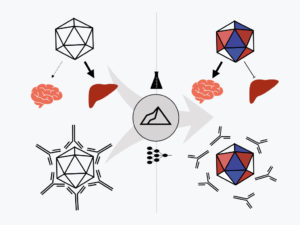Delivering gene therapy’s promise
January 26, 2021
The human body consists of trillions of cells, each possessing their own copy of DNA that provides the blueprint for making a human. Despite sharing the same DNA, different cells activate a varied mix of genes within them to enable differentiation into various tissues and organs. For millions of people, unfortunately, some of these genes do not function properly, resulting in diseases and conditions that are sometimes severely debilitating.
Currently, there are thousands of diseases of different organs that can be cured if the set of cells that rely on the defective gene are provided with a healthy copy of it. However, a significant obstacle in achieving such a cure is that it is challenging to deliver genes into the correct set of cells. The most promising route that is currently available uses AAV capsids, protein shells derived from the naturally benign human Adeno-associated Virus (AAV), as a vector to carry the healthy copy of the gene to the diseased organ or tissue. Unfortunately, natural AAV capsids have not evolved to be specialized in the way needed to deliver therapeutic genes. Most AAV capsids are not able to target a specific organ or tissue that a particular treatment requires. Moreover, the human immune system is familiar with these natural strains, and can quickly neutralize them when used for gene therapy, preventing them from reaching their destination.

To circumvent this problem, the traditional way of engineering natural viruses has been to evolve them in the lab, generating new synthetic viruses that are both novel to the immune system and have higher affinity to the target tissue. Apart from being time-consuming, this process scales poorly as the lessons learned from one experiment don’t generalize to others. There are multiple reasons for this. For instance, the process of generating novelty to select from cannot be precisely controlled during an experiment, but rather occurs by random genetic mutations. With this approach, the traits of interest might simply be too rare to find with random variation. Additionally, using experimental selection processes to improve a specific property often presents a risk of losing other desirable properties of a capsid that are not being selected. An evolutionary path taken in one experiment may not be repeatable for other traits, and the experimental heuristics learned could be irrelevant for other properties. Given these significant shortcomings, success in the field has been limited to those experiments which just happened to produce good results for a particular therapy.
Dyno has instead opted to build a platform that aims to solve the delivery problem for all therapies, thereby removing a major obstacle for realizing effective gene therapies across thousands of diseases. Dyno’s model is built on the recognition that designing capsids capable of delivering genes to different organs and tissues share commonality that if captured, enables the design of specialized vectors quickly and efficiently. To pursue this opportunity, our platform combines two cutting-edge technologies:
- First, it makes use of the most recent developments in artificial intelligence, to build a smart system capable of learning patterns within the virus’ coat that can help it hide from the immune system and more effectively target organs and tissues of interest.
- Second, it proposes millions of sequences, which can be directly and accurately synthesized using the recent advances in DNA technology. These viruses are then experimentally validated in primates.
Data gathered from these validation experiments help making Dyno’s AI smarter, which in turn can help produce better and more diverse viruses. Dyno contends that over time, its AI system will become smart enough to design viruses that are capable of targeting any organ or cell type in the body and predict whether it will work in humans, without the need for multiple experiments. The efficiency of our AI platform only grows as we engage with more partners to produce delivery vectors for different tissues and indications.
This is why Dyno’s approach has generated interest from companies that are industry leaders in gene therapy. Better delivery vectors are impactful and easy to adopt for current and future therapies. Our partners recognize the value of this technology and are helping to validate this approach – all the way into the clinic. Together with our partners, we hope to reach new heights in the gene therapy landscape and unlock its promise for the millions of patients whose life would be transformed by effective delivery of a new gene.